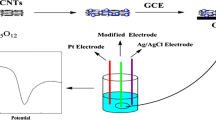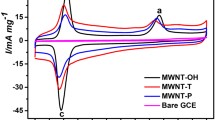Abstract
This work presents new insights on the electrocatalytic reduction of 2,4,6-trinitrotoluene (TNT) on carbon nanotubes (CNTs)-modified electrodes (multi-walled carbon nanotubes and double-walled carbon nanotubes). Cyclic voltammetry showed at least 5-fold current increase in the electrochemical reduction of TNT on GCE modified with pristine (“as received”) CNTs. The improved performance was also verified after 60 s of accumulation and scanning using adsorptive stripping voltammetry, with slope values 20-fold higher. Acid functionalization removed residual metals from CNTs and reduced their surface area. Hence, the improved electrochemical response of TNT on pristine CNTs seems to be not only due to surface roughness (electroactive area) but mainly originating from residual metallic catalysts on CNTs. The modified electrode with pristine CNTs was applied for the determination of TNT residues on different surfaces contaminated with the explosive, showing its applicability for forensic investigations.





Similar content being viewed by others
References
De Volder MFL, Tawfick SH, Baughman RH, Hart AJ (2013) Carbon nanotubes: Present and future commercial applications. Science 339(6119):535–539
Bozal-Palabiyik B, Dogan-Topal B, Uslu B et al (2013) Sensitive voltammetric assay of etoposide using modified glassy carbon electrode with a dispersion of multi-walled carbon nanotube. J Solid State Electrochem 17:2815–2822
Dogan-Topal B (2013) Electrooxidative behavior and determination of trifluoperazine at multiwalled carbon nanotube-modified glassy carbon electrode. J Solid State Electrochem 17:1059–1066
Fagan-Murphy A, Kataria S, Patel BA (2016) Electrochemical performance of multi-walled carbon nanotube composite electrodes is enhanced with larger diameters and reduced specific surface area. J Solid State Electrochem 20:785–792
Rezaei B, Damiri S (2010) Development of a voltammetric procedure for assay of thebaine at a multi-walled carbon nanotubes electrode: Quantification and electrochemical studies. J Solid State Electrochem 14:1079–1088
De Zhang W, Xu B, Hong YX et al (2010) Electrochemical oxidation of salicylic acid at well-aligned multiwalled carbon nanotube electrode and its detection. J Solid State Electrochem 14:1713–1718
Ziyatdinova G, Gainetdinova A, Morozov M et al (2012) Voltammetric detection of synthetic water-soluble phenolic antioxidants using carbon nanotube based electrodes. J Solid State Electrochem 16:127–134
Zukalová M, Tarábek J, Kalbáč M et al (2008) In situ optical spectroelectrochemistry of single-walled carbon nanotube thin films. J Solid State Electrochem 12:1279–1284
Ordeñana-Martínez AS, Rincón ME, Vargas M et al (2012) Carbon nanotubes/carbon xerogel-nafion electrodes: A comparative study of preparation methods. J Solid State Electrochem 16:3777–3782
Montes RHO, Dornellas RM, Silva LAJ et al (2016) Amperometric determination of the insecticide fipronil using batch injection analysis: comparison between unmodified and carbon-nanotube-modified electrodes. J Solid State Electrochem 20:2453–2459
Moutab Sahihazar M, Ahmadi MT, Nouri M, Rahmani M (2019) Quantum conductance investigation on carbon nanotube–based antibiotic sensor. J Solid State Electrochem 23:1641–1650
Banks CE, Crossley A, Salter C et al (2006) Carbon nanotubes contain metal impurities which are responsible for the “electrocatalysis” seen at some nanotube-modified electrodes. Angew Chemie - Int Ed 45:2533–2537
Stefano JS, Rocha DP, Dornellas RM et al (2017) Highly sensitive amperometric detection of drugs and antioxidants on non-functionalized multi-walled carbon nanotubes: Effect of metallic impurities? Electrochim Acta 240:80–89
Wang J (2005) Carbon-nanotube based electrochemical biosensors: A review. Electroanalysis 17:7–14
Cardoso RM, Montes RHO, Lima AP et al (2015) Multi-walled carbon nanotubes: Size-dependent electrochemistry of phenolic compounds. Electrochim Acta 176:36–43
Pumera M, Miyahara Y (2009) What amount of metallic impurities in carbon nanotubes is small enough not to dominate their redox properties? Nanoscale 1:260–265
Smith JP, Foster CW, Metters JP et al (2014) Metallic Impurities in Graphene Screen-Printed Electrodes Can Influence Their Electrochemical Properties. Electroanalysis 26:2429–2433
Kruusma J, Mould N, Jurkschat K et al (2007) Single walled carbon nanotubes contain residual iron oxide impurities which can dominate their electrochemical activity. Electrochem commun 9:2330–2333
Pumera M (2007) Carbon nanotubes contain residual metal catalyst nanoparticles even after washing with nitric acid at elevated temperature because these metal nanoparticles are sheathed by several graphene sheets. Langmuir 23:6453–6458
Mendoza E, Henley SJ, Poa CHP et al (2005) Large area growth of carbon nanotube arrays for sensing platforms. Sensors Actuators, B Chem 109:75–80
Pumera M, Iwai H (2009) Metallic impurities within residual catalyst metallic nanoparticles are in some cases responsible for “electrocatalytic” effect of carbon nanotubes. Chem - An Asian J 4:554–560
Jones CP, Jurkschat K, Crossley A et al (2007) Use of high-purity metal-catalyst-free multiwalled carbon nanotubes to avoid potential experimental misinterpretations. Langmuir 23:9501–9504
Alwarappan S, Erdem A, Liu C, Li C-Z (2009) Probing the Electrochemical Properties of Graphene Nanosheets for Biosensing Applications. J Phys Chem C 113:8853–8857
Wang L, Chua C, Khezri B, Webster R (2016) Remarkable electrochemical properties of electrochemically reduced graphene oxide towards oxygen reduction reaction are caused by residual metal-based. Electrochemistry 62:17–20
Sljukić B, Banks CE, Compton RG (2006) Iron oxide particles are the active sites for hydrogen peroxide sensing at multiwalled carbon nanotube modified electrodes. Nano Lett 6:1556–1558
Dai X, Wildgoose GG, Compton RG (2006) Apparent “electrocatalytic” activity of multiwalled carbon nanotubes in the detection of the anaesthetic halothane: occluded copper nanoparticles. Analyst 131:901–906
Yu HA, DeTata DA, Lewis SW, Silvester DS (2017) Recent developments in the electrochemical detection of explosives: Towards field-deployable devices for forensic science. TrAC - Trends Anal Chem 97:374–384
Pereira De Oliveira L, Rocha DP, Reis De Araujo W et al (2018) Forensics in hand: New trends in forensic devices (2013-2017). Anal Methods 10:5135–5163
de Araujo WR, Cardoso TMG, da Rocha RG et al (2018) Portable analytical platforms for forensic chemistry: A review. Anal Chim Acta 1034:1–21
Wang J, Hocevar SB, Ogorevc B (2004) Carbon nanotube-modified glassy carbon electrode for adsorptive stripping voltammetric detection of ultratrace levels of 2,4,6-trinitrotoluene. Electrochem commun 6:176–179
Pedrotti JJ, Angnes L, Gutz IGR (1996) Miniaturized reference electrodes with microporous polymer junctions. Electroanalysis 8:673–675
Vuković G, Marinković A, Obradović M et al (2009) Synthesis, characterization and cytotoxicity of surface amino-functionalized water-dispersible multi-walled carbon nanotubes. Appl Surf Sci 255:8067–8075
Krzyzaniak SR, Iop GD, Holkem AP et al (2019) Determination of inorganic contaminants in carbon nanotubes by plasma- based techniques : Overcoming the limitations of sample preparation. Talanta 192:255–262
Brauner S, Emmet PH, Teller E (1936) Adsorption of Gases in Multimolecular Layers. J Am Chem Soc 60:309–319
Barrett EP, Joyner LG, Halenda PP (1951) The Determination of Pore Volume and Area Distributions in Porous Substances. I. Computations from Nitrogen Isotherms. J Am Chem Soc 73:373–380
Chua CK, Pumera M, Rulíšek L (2012) Reduction pathways of 2,4,6-trinitrotoluene: An electrochemical and theoretical study. J Phys Chem C 116:4243–4251
Castro SVF, Cardoso RM, Santana MHP et al (2019) Graphite sheet as a novel material for the collection and electrochemical sensing of explosive residues. Talanta 203:106–111
Yang R, Wei Y, Yu Y et al (2012) Make it different: The plasma treated multi-walled carbon nanotubes improve electrochemical performances toward nitroaromatic compounds. Electrochim Acta 76:354–362
Lima AP, Catto AC, Longo E et al (2019) Investigation on acid functionalization of double-walled carbon nanotubes of different lengths on the development of amperometric sensors. Electrochim Acta 299:762–771
Ehrenberg H, Svoboda I, Wiesmann M et al (1999) A mixed transition metal molybdate, β-(Co0. 7Fe0. 3) MoO4. Acta Cryst C 55:1383–1384
Stuart EJE, Pumera M (2010) Electrochemistry of a whole group of compounds affected by metallic impurities within carbon nanotubes. J Phys Chem C 114:21296–21298
Cañete-Rosales P, Ortega V, Álvarez-Lueje A et al (2012) Influence of size and oxidative treatments of multi-walled carbon nanotubes on their electrocatalytic properties. Electrochim Acta 62:163–171
Mkhondo NB, Magadzu T (2014) Effects of different acid-treatment on the nanostructure and performance of carbon nanotubes in electrochemical hydrogen storage. Dig J Nanomater Biostructures 9:1331–1338
Hrapovic S, Majid E, Liu Y et al (2006) Metallic nanoparticle-carbon nanotube composites for electrochemical determination of explosive nitroaromatic compounds. Anal Chem 78:5504–5512
Acknowledgements
The authors are grateful to CAPES (PRO FORENSES–Process number 23038.007073/2014-12 and 001), CNPq (465389/2014-7 INCTBio and 307271/2017-0), FAPESP (2018/16896-7), FAPEMIG (RED-00042-16) for financial support. The authors would also like to thank the department of chemistry at Federal University of Minas Gerais for supplying the TNT samples and for assistance in the analysis. This work was partially supported by the Brazilian Institute of Science and Technology (INCT) in Bioanalytics (INCTBio) and in Carbon nanomaterials (INCTCarbon). We also thank the facilities for the AFM measurements at the Institute of Physics (INFIS) at Federal University of Uberlândia (UFU), supported by the grant “Pró-Equipamentos” from the Brazilian Agency CAPES. We also thank Prof. Koiti Araki (Laboratório de Química Supramolecular e Nanotecnologia, IQ-USP) for the use of XRD facility.
Author information
Authors and Affiliations
Corresponding author
Additional information
Publisher’s note
Springer Nature remains neutral with regard to jurisdictional claims in published maps and institutional affiliations.
Electronic supplementary material
ESM 1
(DOCX 799 kb)
Rights and permissions
About this article
Cite this article
Stefano, J.S., Lima, A.P., Nascentes, C.C. et al. Electrochemical detection of 2,4,6-trinitrotoluene on carbon nanotube modified electrode: Effect of acid functionalization. J Solid State Electrochem 24, 121–129 (2020). https://doi.org/10.1007/s10008-019-04465-5
Received:
Revised:
Accepted:
Published:
Issue Date:
DOI: https://doi.org/10.1007/s10008-019-04465-5




